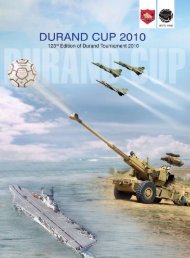Shimla-the birthplace of the Durand Cup and the Indian Air Force ...
Shimla-the birthplace of the Durand Cup and the Indian Air Force ...
Shimla-the birthplace of the Durand Cup and the Indian Air Force ...
You also want an ePaper? Increase the reach of your titles
YUMPU automatically turns print PDFs into web optimized ePapers that Google loves.
2010 to 7 November 2010. The finals was graced by Hon’ble<br />
Minister <strong>of</strong> Youth Affairs <strong>and</strong> Sports, Dr M S Gill. Chirag United<br />
won against JCT Phagwara in a well contested match. The 124th<br />
edition <strong>of</strong> <strong>the</strong> <strong>Cup</strong> will be played in October 2011 at Delhi.<br />
A dramatic match that marked <strong>the</strong> arrival <strong>of</strong> <strong>Indian</strong> football <strong>and</strong><br />
broke <strong>the</strong> British hegemony over <strong>the</strong> sport was <strong>the</strong> <strong>Dur<strong>and</strong></strong> cup<br />
final in 1940 when Mohammendan Sporting <strong>of</strong> Calcutta won<br />
a niche in <strong>the</strong> sport’s ‘Hall <strong>of</strong> Fame”. They lifted <strong>the</strong> glittering<br />
<strong>Dur<strong>and</strong></strong> Trophy, becoming <strong>the</strong> first <strong>Indian</strong> team to achieve <strong>the</strong><br />
feat. The tournament which was held at <strong>the</strong> famous Ann<strong>and</strong>ale<br />
in <strong>Shimla</strong> since its inception in 1988, was shifted to New Delhi<br />
in 1940 in view <strong>of</strong> <strong>the</strong> “policy <strong>of</strong> <strong>the</strong> Government <strong>of</strong> India to<br />
retain many <strong>of</strong> its <strong>of</strong>fices in Delhi”.<br />
Then at <strong>the</strong>ir zenith Mohammedan Sporting crushed one<br />
opposition after ano<strong>the</strong>r to finally take on <strong>the</strong> powerful<br />
Warwickshire Regiment. It was chance that <strong>the</strong> <strong>Indian</strong> team<br />
managed to break <strong>the</strong> complete British Army monopoly in<br />
<strong>the</strong> tournament. Jk Bose recalled in his 1967 article, “The<br />
venue <strong>of</strong> <strong>the</strong> fight was <strong>the</strong> Irwin Amphi<strong>the</strong>atre, which is now<br />
called <strong>the</strong> National Stadium, New Delhi. It was a battle, as <strong>the</strong><br />
nationalist <strong>Indian</strong>s loved to think, between ruled India <strong>and</strong><br />
<strong>the</strong>ir illegitimate ruler, Britain. The stage<br />
was set with <strong>the</strong> picturesque Purana<br />
Qila as its backdrop. The crowds were<br />
distinctly divided into <strong>Indian</strong>s on <strong>the</strong><br />
one side <strong>and</strong> British on <strong>the</strong> o<strong>the</strong>r. They<br />
had settled down hours before Captain<br />
Harnam Singh, a former Secretary <strong>of</strong> <strong>the</strong><br />
<strong>Dur<strong>and</strong></strong> Committee, whistled for <strong>the</strong> kick<strong>of</strong>f.<br />
He was <strong>the</strong> first <strong>Indian</strong> to referee a<br />
<strong>Dur<strong>and</strong></strong> final.<br />
The match began after what appeared to<br />
be a long wait. Amidst crackers from <strong>the</strong><br />
British <strong>and</strong> full-throated shouts from <strong>the</strong><br />
<strong>Indian</strong>s, <strong>the</strong> Mohammedans, who were<br />
all booted, made piercing attacks <strong>and</strong><br />
defended heroically. They retired with<br />
honours even at half-time with <strong>the</strong> score at<br />
one-all. Excitement mounted high as <strong>the</strong><br />
second session began. The clock ticked<br />
by <strong>and</strong> still <strong>the</strong>re was no score. Would <strong>the</strong><br />
golden opportunity for <strong>the</strong> <strong>Indian</strong> team<br />
14 July 2011 purple beret<br />
slip? The <strong>Indian</strong>s became restive but not for long. In <strong>the</strong> 20 th<br />
minute <strong>the</strong> Calcutta forwards initiated a delectable move <strong>and</strong><br />
<strong>the</strong>ir slick inside-left Saboo scored <strong>the</strong> match-winner.<br />
It was an unforgettable sight <strong>of</strong> joy <strong>and</strong> jubilation as <strong>the</strong> referee<br />
blew <strong>the</strong> long whistle. The <strong>Indian</strong>s were uncontrollable, each<br />
one <strong>of</strong> <strong>the</strong>m trying to greet <strong>the</strong>ir eleven heroes. I cannot<br />
recollect whe<strong>the</strong>r Osman, Hafiz, Rashid <strong>and</strong> Bachi Khan, all<br />
ex-Delhi players, received special cheers. All that I remember<br />
is that along with <strong>the</strong>m Saboo, Noor Mohammad (jr), Jumma<br />
Khan, Rashid, Masoom, AM Hussain, Karim <strong>and</strong> Rahman<br />
received perhaps <strong>the</strong> biggest ovation <strong>of</strong> <strong>the</strong>ir lives. Warman,<br />
Harris, Lewis, Wharton <strong>and</strong> company <strong>of</strong> <strong>the</strong> Warwickshire<br />
Regiment surrendered to <strong>the</strong> might <strong>of</strong> <strong>the</strong> Calcutta team who<br />
won all o<strong>the</strong>r major soccer trophies except <strong>the</strong> I.F.A. Shield in<br />
that year.<br />
Mohammedan Sporting’s triumph came after years <strong>of</strong> glorious<br />
but vain attempts by o<strong>the</strong>r teams to break <strong>the</strong> British monopoly.<br />
It was, however, ano<strong>the</strong>r <strong>Indian</strong> side, East <strong>Indian</strong> Railways<br />
who made <strong>the</strong> final for <strong>the</strong> first time in 1927. Assisted by giants<br />
like Samad, Rabi Gan Bhowmick <strong>and</strong> B. Das <strong>the</strong> Railway went<br />
down gallantly to <strong>the</strong> York <strong>and</strong> Lancashire Regim 2-0.<br />
Young Men <strong>of</strong> Delhi, who once reached<br />
<strong>the</strong> semi-final, S<strong>and</strong>amoniums <strong>of</strong><br />
Quetta, Loco Sh Lahore, Collegians<br />
<strong>and</strong> a host <strong>of</strong> o<strong>the</strong>r teams were regular<br />
visitors to <strong>Shimla</strong>. Mohun Bagan had<br />
won <strong>the</strong> I.F.A. Shield in <strong>the</strong> epochmaking<br />
1911, began to make <strong>the</strong>ir<br />
appearance in <strong>the</strong> <strong>Dur<strong>and</strong></strong> from <strong>the</strong><br />
1920’s. Even if <strong>the</strong>y were beaten <strong>the</strong>y<br />
left an indelible impression.<br />
The national feeling was evident every<br />
time an <strong>Indian</strong> team participated. The<br />
feeling was never greater than <strong>the</strong><br />
memorable full tie between Calcutta’s<br />
Aryan Club <strong>and</strong> Green Howards in 1936.<br />
The footed Aryans, ably guided by <strong>the</strong>ir<br />
mentor Chhoney Mazumdar, not only<br />
matched <strong>the</strong> skill <strong>of</strong> redoutable rivals<br />
but nearly downed <strong>the</strong>m. The Aryans<br />
were right on top, an eye-witness tells



